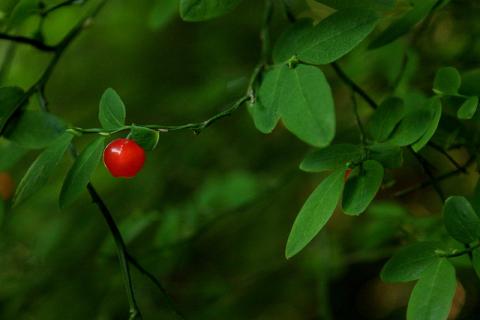
Image Credit: Walter Siegmund
Common name(s): red huckleberry, red whortleberry
General bloom time: leaves emerge in early spring, flowering from April to June, ripe fruit between August and September
Identification: 4 meter tall deciduous shrub; maintains some leaves year-round; branches are long, skinny, bright green branches
Leaves: alternate, green, oval shaped, usually not toothed, 3 cm leaves
Flowers: pinkish to yellowish-green bell shaped flowers, about 5 mm long that grow in-between the leaf and the branch
Fruit: red, round berries, about 1 cm in diameter; berries are edible but slightly sour
Habitat: grows mainly on the edge of coniferous forests; sun and shade tolerant; soil should be dry to moist and rich in decayed wood; lower to mid elevations
Ecology:Provides berries for birds, supports benficial insects.

Image Credit: Leslie Seaton
Fun Facts:
- The berries were often used as fish bait since they have the resemblance to the salmon egg in size and color
- Used as a mouthwash and to stimulate the appetite
- Some natives believe that the plant was created by Asin, the monster woman of the woods, and that people who eat the berry lose their reason and had to be carried out of the woods
- Seeds are dispersed by birds, deer, and banana slugs
- Quickly re-spouts after fires
Places to find in Portland: Forest Park
References:
Tirmenstein, Debra A. 1990. Vaccinium parvifolium. In: Fire Effects Information System [online]. U.S. Department of Agriculture, Forest Service, Rocky Mountain Research Station, Fire Sciences Laboratory (Producer). 2008, January 22. http://www.fs.fed.us/database/feis/plants/shrub/vacpar/all.html
Holm, Freya G. The Natural History of Vaccinium parvifolium Smith, the Red Huckleberry. June 30, 2004. January 18, 2004.
Pojar, J. and Mackinnon, A. 1994. Plants of the Pacific Northwest Coast. Vancouver, B.C.: Lone Pine Publishing.